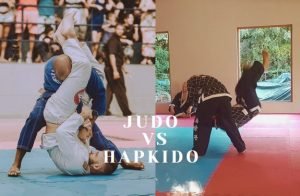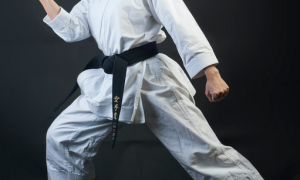
Is karate good for self-defense? Karate has earned a reputation as a battle-hardened martial art ready to arm you with survival skills when danger strikes. The punches, blocks, and kicks of Karate seem tailor-made to transform average joes into unstoppable forces on the streets. But is the legend and lore surrounding Karate’s self-defense capabilities fully accurate? Does Karate truly live up to its mythical status as the knight in shining armor when violent threats emerge?
Before signing up for that Karate McDojo, let’s peel back the layers and scrutinize whether Karate is truly as good for real-world self-defense as advertised. Remember, no martial art is a magic bullet, so we need to separate hype from reality regarding Karate’s ability to keep you safe when things get ugly. Time to find out if “Is Karate good for self-defense?” deserves a resounding yes or a more nuanced answer.
Table of Contents
Toggle![]()
In short:
Yes, karate can be an effective martial art for real-world self-defense, but its effectiveness depends on the style and training methods used. Traditional karate styles like Uechi Ryu with an uncompromising focus on pragmatic street defense tend to be most applicable to protecting oneself. However, sport-oriented styles that emphasize choreography over combat proficiency may not provide reliable self-protection skills. In general, karate is good for self-defense, but specific styles and proper training approach matter greatly.
![]()
Best Karate Styles for Self Defense
When seeking a karate style for pragmatic real-world self-protection, not all are created equal. There is much debate around styles like Shotokan, Goju Ryu, and Kenpo karate in terms of effectiveness for true self-defense situations. To understand which style of karate is most effective for self-defense, we need to go beyond the traditional katas and diving deeper into aspects like: how street-focused the training and techniques are, the levels of full contact sparring involved, adaptability to chaos, and simplicity of moves for an instinctive response.
By analyzing categories like these, we can determine which karate style is optimized for handling the volatile realities of sudden street violence and literally defending yourself against unprovoked attacks. Practical karate styles focused on hardcore self-defense like Uechi Ryu clearly stand above more theatrical sport karate when it comes to functionality in uncontrolled real fight scenarios.
Hallmarks of an Effective Self-Defense Karate Style:
- Practical techniques designed for street effectiveness
- Sparring with full resistance and contact
- Unpredictable drills simulating real assaults
- Adaptable mindset to fluidly respond to chaos
- Minimal complex moves – simple and instinctive is best
How Do the Major Karate Styles Compare?
| Style | Street Focus | Sparring | Adaptability | Simplicity | Total |
|---|---|---|---|---|---|
| Uechi Ryu | High | High | Moderate | High | 4/5 |
| Shotokan | Moderate | Low | High | Moderate | 3/5 |
| Goju Ryu | Moderate | Moderate | High | Low | 3/5 |
| Kenpo | High | High | High | Moderate | 4/5 |
Analysis:
- Uechi Ryu stands out as optimized for self-defense with its street-ready stances, high-contact sparring, and focus on simplicity.
- Kenpo also shines with its emphasis on close-quarter rapid-fire techniques and adaptable mindset.
- Shotokan and Goju Ryu lag behind in sparring intensity and simplicity. Better suited for sport.
Uechi Ryu:
Uechi Ryu stands out among karate styles for its relentless focus on real-world functionality and self-defense.
- Stances are lower and guarded – suited for rapid engagement or defense.
- Open-hand spear strikes target soft tissues and vulnerable points.
- Training emphasizes body hardening and absorbing blows.
- Sparring is continuous and full-contact.
Uechi Ryu reminds us karate was originally forged as a life-protection art. It retains that street fighting DNA in its techniques and warrior mindset.
Shotokan:
Shotokan earned its reputation as the flamboyant style of karate.
- Deep stances generate tremendous power in strikes and kicks.
- Dynamic combinations demonstrate athleticism and control.
- Circular movements build fluidity between techniques.
- Competitive kumite matches test reaction speed and strategy.
Shotokan captures the artistic beauty and lethal potential contained within karate.
Wado Ryu:
Wado Ryu stands out for its economy of movement and evasive footwork.
- Low stances and angled positioning frustrate attackers.
- Redirecting movements turn an opponent’s energy against them.
- Counterstrikes are executed with precise timing and efficiency.
- Defense and offense blend seamlessly together.
Wado Ryu exemplifies how proper positioning and movement can nullify brute force.
Goju Ryu:
Goju Ryu integrates hard and soft techniques into a cohesive whole.
- Tight, stable stances project strength.
- Circular blocks redirect attacks with flowing energy.
- Thrusting strikes target vital points with penetration.
- Kata practice cultivates inner power, rhythm, and balance.
Goju Ryu finds power in harmonizing hard and soft. This synthesis leads to true mastery of body and mind.
Key Takeaways for Selecting Your Karate Self-Defense Style
- Train for the streets, not for points – sparring intensity is crucial
- Choose pragmatism over pageantry – complex katas won’t save you
- Opt for simple, instinctive techniques over acrobatics
- The student makes the style – train with self-protection as the goal
Focus less on textbook techniques and more on cultivating an unstoppable survival mindset. That is the true essence of self-defense karate.
Compare Uechi Ryu vs Goju Ryu in our article for an even deeper insight
![]()
The Evolution of Karate and Self-Defense
Karate has undergone an intriguing transformation over the centuries. This martial art was originally sculpted as a lethal form of self-defense on the battlefields of Okinawa. But flash forward to today, and much of karate’s focus has shifted significantly toward character development, spiritual growth, and competition.
Back in the 14th century, with weapons banned in Okinawa, karate emerged as a necessity for self-preservation. Its primary purpose was pragmatic – to be an effective system of hand-to-hand combat for defending one’s life. The katas, punches, kicks, and stances were created explicitly for self-defense and defeating armed adversaries. Karate training meant survival.
Over time though, as karate proliferated and blended with other influences, things began to change. While still practiced for self-defense, many styles started emphasizing personal character building, as much as physical skills. Temple karate focused on spiritual cultivation, while new sport variations optimized techniques for points tournaments.
So does karate still remain a viable self-defense system today? Absolutely, but it depends on the style, instruction, and application. Pragmatic, reality-based styles like Uechi Ryu continue to focus on street-effective techniques and warrior mindset. And even flashy tournament styles can still be adapted for real-world defense.
At the core of powerful karate remains its energy and principles cultivated for generations. With the right training, karate can still be an incredibly effective martial art for self-defense in the 21st century. The key is maintaining the correct mindset and practicing techniques with martial applicability – not just performance. A balance between traditional karate’s roots and evolution is what will keep its self-defense essence alive.
![]()
Does Karate Work in Street Fights?
Can karate work in uncontrolled street fights? This is the true litmus test for any martial art claiming self-defense value. Let’s analyze how to bridge the gap between traditional karate training and real-world application.
In the Dojo:
Traditional karate classes often focus on perfecting textbook techniques, kata routines, and point-based sparring matches. The training is highly structured with preset routines and rules. Safety is also paramount. While these methods have benefits, they don’t adequately prepare students for chaotic street violence.
In the Streets:
Real fights are ugly, frantic, and emotionally charged. There are no rules, referees, or padding. Attacks come suddenly from all angles with pure intent to harm. It’s a grim reality that demands preparation well beyond controlled dojo training. Survival depends on instinctual technique execution and a fierce will to endure violence.
Bridging the Gap:
For karate to work under street pressures, training must evolve. While maintaining artistry and tradition, karateka need exposure to energy and conditioning drills, full-contact sparring, varied attacks, and simulated street scenarios. This pressure tests skills and forges the mental fortitude needed when every movement has consequence. Adaptability, ferocity, and unshakable confidence become just as important as precise technique.
Karate trained rigorously under realistic conditions, both physical and psychological, can absolutely serve as formidable self-protection. But without pressure testing, even the most masterful karateka may freeze when slammed with street violence. Prepare for the worst, hope for the best. This maxim holds true in both the dojo and the streets.
![]()
FAQ about Karate’s Self Defense
![]()
Can Karate help you in a real fight?
Yes, karate can absolutely be effective in a real self-defense situation – but it depends on your training. Karate focused on adapting techniques, mindset, and conditioning for the chaos of the streets will provide practical skills. Sport karate that relies on point scoring may fall short in uncontrolled fights. Proper application of karate skills with intensity and aggression is key.
Does Karate make you tougher?
Karate can certainly enhance both physical and mental toughness. The intense conditioning forges a body capable of generating and absorbing impact while building endurance. Frequent sparring also develops the ability to push through pain and exhaustion. On a mental level, karate instills an indomitable spirit – never giving up regardless of adversity faced. So yes, proper karate training definitely develops toughness.
Can Karate save your life?
There are countless real-world examples of karate skills saving lives in self-defense situations. By ingraining reflexive blocking and striking techniques, along with the awareness to use them, karate can provide the tools needed to defend against violence. Developing the mental preparedness to act decisively against threats is also key. So while not a guarantee, the skills and mindset from karate may mean the difference between life and death.
![]()


